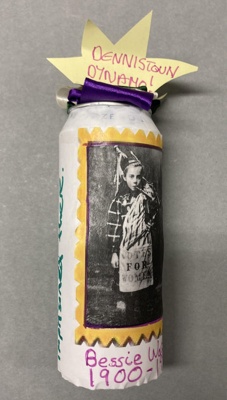Name/TitleDennistoun Dynamo: Bessie Watson
About this object'Dennistoun Dynamo: Bessie Watson, a collage-covered can inspired by the wall of Tennent's 'Lager Lovelies' during the Discover Women’s History in Dennistoun project run by Glasgow Women's Library in 2023-24. The can features an image and handwritten description of suffragette piper Bessie Watson, and the top is decorated with a green, white and purple rosette.
MakerSmith, Morag
Date Made2024
Period2020s
Place MadeScotland, Glasgow
Medium and MaterialsInorganic, tin
Organic, paper
MeasurementsH: 220 x Dia: 70 mm
Subject and Association KeywordsGlasgow history
Subject and Association Keywordssuffragettes, militant suffrage campaign
Subject and Association Descriptionhttps://en.wikipedia.org/wiki/Dennistoun:
Dennistoun (/ˈdɛnɪstən/) is a mostly residential district in Glasgow, Scotland, located north of the River Clyde and in the city's east end, about 1+1⁄4 miles (2 kilometres) east of the city centre. Since 2017 it has formed the core of a Dennistoun ward under Glasgow City Council, having previously been a component of the East Centre ward. Aside from the smaller Haghill neighbourhood further east, Dennistoun's built environment does not adjoin any others directly, with the M8 motorway dividing it from Royston to the north, while the buildings of Glasgow Royal Infirmary and Wellpark Brewery plus the Glasgow Necropolis cemetery lie to the west (separating it from adjacent Townhead), and railway lines form the southern boundary with the Calton/Gallowgate neighbourhoods, and Camlachie (a historic district which is now largely a retail park) on the opposite side [continues].
https://womenslibrary.org.uk/2023/06/01/discovering-womens-heritage-in-dennistoun:
[Published June 2023] We are really excited about a new project that is just starting up in Dennistoun, thanks to funding from the Glasgow City Council Local Area Fund. GWL will be working with local women and organisations to uncover some of the history and heritage of Dennistoun women. We’ll be looking at some of the women who worked in Dennistoun’s industries, such as breweries and cigarette factories. We’ll be looking at the history of Duke Street jail, at the women who worked on the trams and buses and also at the lives of working class women who moved to the area during or after the Second World War. Dennistoun has grown over the years to be a hugely diverse area, from the grand old terraced houses of Anfield Square to the tenements and bustling businesses in Duke Street. We’ll be offering the chance for women to share their stories and memories, develop their skills in historical research and take part in fun creative activities responding to what we discover. The project will also be looking into Glasgow based archives and also our own archive at the women’s library, where we have discovered photographs and letters from two sisters and their family who lived in Dennistoun and attended Golfhill School, so we can’t wait to investigate and find out more about their history! [continues]
https://en.wikipedia.org/wiki/Bessie_Watson:
Elizabeth Watson (13 July 1900 – 27 June 1992) was a Scottish child suffragette and piper. ... After seeing an advert for a pageant of historical Scottish women organised by Flora Drummond and the Women's Social and Political Union, Watson and her mother joined the WSPU and Watson, at the age of 9, was invited to play the pipes in the pageant. The procession, which celebrated "What women have done and can and will do", took place in Edinburgh on 9 October 1909 and marched down Princes Street before gathering for a rally led by Emmeline Pankhurst at Waverley Market. Watson rode on a float beside a woman dressed as Isabella McDuff, Countess of Buchan in her cage. Several weeks later when Christabel Pankhurst came to Edinburgh to attend a meeting in the King's Theatre, she presented Watson with a brooch depicting Boudica in her chariot. In 1979 Bessie gave this brooch to Margaret Thatcher, the first woman to be elected as Prime Minister of the UK. Two years after the pageant Watson was invited to lead the Scottish "lady" pipers at the Great Pageant in London on 17 June 1911. Later that same year, when King George V came to Edinburgh on a state visit, Watson led the 2nd Edinburgh Company of the Girl Guides and was recognised by the King as she raised the salute. Watson continued to be actively involved in the Suffragette movement and wore hair ribbons in the colours of the Suffragette campaign to school. She played the pipes on the platform of Waverley Station as trains departed taking convicted women's rights campaigners to Holloway Prison, and she piped outside Calton Jail* to encourage the Suffragettes imprisoned there [continues].
*And Duke St Prison, Dennistoun
Named CollectionGlasgow Women's Library
Object TypeArtwork
Object numberGWL-2024-53-4
Copyright LicenceAll rights reserved


